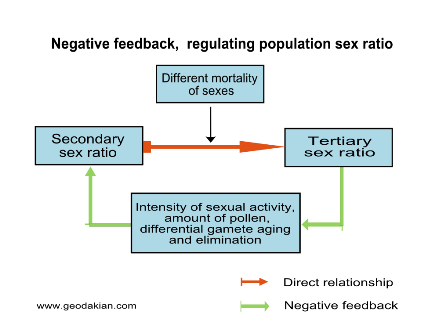|
The Evolutionary Theory of
Sex: Sex
Ratio

Sex ratio (SR) is one of the main
characteristics of sexual population. Generally it is
determined by the number of males per 100 females, or in
percents. In relation to Ontogeny stage we distinguish
primary (I SR), secondary (II SR) and tertiary (III SR) SR.
Primary is zygote SR after fertilization; secondary - SR at
birth; and tertiary - SR of mature organisms.
The main sex determination mechanism
in many animals and plants species is chromosomal. Since the
gametogenesis process produces an equal number of X- and
Y-gametes, one may consider that this mechanism provides
nearly equal quantities of sexes.
According to the new concept tertiary
SR determines the proportion between maintenance and
variation tendencies as well as the species evolutionary
flexibility. At different stages of evolution, and also in
different environmental conditions population needs
different evolutionary flexibility (and consequently there
exists a definite optimal tertiary SR value for each of
these conditions). And this value is not necessarily equal
to 1:1. Secondary SR is also a variable dependent on the
environment, rather than a constant specific for a species,
as it was believed. In stable environment secondary SR is at
its optimum level.
The extreme
environment and "turnover" of males
Under extreme conditions, as a rule,
more males are extinct and simultaneously more males are
required for selection. Both males’ mortality and males’
birth-rate increase imply “turnover” of males increase.
In 1965 it was proposed that besides the direct relationship,
there exists a negative feedback between secondary SR and
tertiary one (Fig.).

Two negative feedback mechanisms are
possible:
1. The initially genetically determined probability to have
offspring of given sex is equal for all males and females in
population, but environmental conditions may bring about
change in this probability. This mechanism may be called
organismic, or physiological. It may regulate SR only in
polygamous or panmictic population.
2. Different organisms have genetically determined different
probability to produce offspring of a given sex and this
probability is related to hierarchical, social range of an
animal. With this mechanism regulation may be on the
population level, through greater or lesser participation of
individuals, giving birth to more males or females. This
mechanism may be called populational. For the negative
feedback to work, the dominant (α-range) males should have
low probability to produce more males in the progeny, while
subordinate (Ω-range) males should have more males.
Regulation is accomplished by changing the participation in
reproduction of individuals of different range. Unlike the
organismic mechanism, the populational mechanism may
regulate the SR not only in polygamous or panmictic, but
also in fully monogamous populations.
Mechanisms of
organismic regulation
For the organismic type of regulation
these factors are: a) the amount
of pollen caught on the female flower: the amount is
directly proportional to the number of male flowers
surrounding the female flower, and consequently, tertiary
SR; b) pollen aging and
elimination: the more male plants there are around the
female plant, the less time is needed to pollination and
vise versa; c) for polygamous or
panmictic animals - the intensity of sexual activity, which
is directly related to the number of the same sex, and
reversely proportional to the number of the opposite sex,
thus also dependent on tertiary SR; d)
male or female gametes aging and elimination (delayed
fertilization); the aging probability in the organism of
abundant sex is always greater than in the organism of
deficient sex, so there exists a relation between gamete
aging and tertiary SR (Fig.).
Negative feedback in insects.
Bees and other hymenoptera, ticks have an unusual negative
feedback mechanism. From fertilized eggs only females (or
females and males) are born, while from unfertilized ones -
only males are developed. Generally, the fewer males there
are in the initial population, the fewer eggs are
fertilized, and more males appear in offspring.
SR and sexual activity.
Intensity of sexual activity (ISA) may be the chain link
between the tertiary SR and the secondary SR in animals (Geodakian,
1965). On the one hand, it depends on the tertiary SR: for
each sex the activity diminishes with the increase of the
number of individuals of one's own sex, and increases, when
the opposite sex number rises. On the other hand, ISA is
related with organismic physiological parameters.
Consequently, if negative feedback relation exists, and is
realized through ISA, then high male birth-rate on high ISA
of males will be observed. Low male ISA will result in high
female birth-rate. For females the picture is reversed: high
female ISA results in an increased female birth-rate
probability, low - males. So, high ISA increases the
probability of the birth of a child of the same sex, low ISA
- the birth of a child of opposite sex.
The negative feedback concept was
confirmed in direct experiments on at least 3 species: 1
plant and 2 animal ones. Many plant, and animal species and
also humans have necessary mechanisms for its existence (4
plant species from 3 families, and 16 animal species from 11
families).

Humans
are not strongly monogamous, therefore different secondary
sex ratio deviations from 1:1 may arise. For Nigerians
Thomas (1913)
has reported secondary sex ratio values in relation to wives
number
(Figure). It may be concluded that there exists a reverse
relation
between secondary and tertiary sex ratio. Furthermore, if a
negative
feedback exists, an increase of the secondary sex ratio can
be
observed in harems. Figure shows data on three harems: Chu
Juanchshan (U Han, 1980) (1328-1398, China), Ramses II (Ebers,
1965)
(1317-1251 B. C., Egypt), and Mauli Ismail (Asia and Africa today,
1970) (1646-1727, Morocco). These data are not easy to
account for
by purely stochastic sex determination. The probability of
random
deviation from 1:1 under such boy excess is 10-15.
The number of
mothers and progeny makes the effect statistically
significant;
however the number of fathers is small.
Populational mechanisms of sex ratio regulation
Two things are required for the
realization of the populational mechanism. First it is
necessary that in a population there was a genetically
caused polymorphism on probability to leave posterity with
the certain sex ratio. And second, that this probability
should be in reverse correlation with a reproductive rank
of a person—the higher the reproductive rank, the more
offspring of an opposite sex the person should produce.
Reproductive rank of a male (access to marriage
partners) correlates, as a rule, with their
social-hierarchical rank (access to resources in
general). Females may have a reverse correlation, because
their hierarchical rank, as well as for males, is defined by
their strength and aggressiveness, but reproductive one can
be determined more by their appeal and compliance.
Expected sex of offspring in
various conditions
In natural conditions disturbances of
tertiary sex ratio from optimum always make one sex
“deficient” and the other—“abundant” with opposite changes
of their states. Deficient sex, in average, has more ISA,
frequently have sex saturation, in fertilization participate
more freshly gametes etc. And abundant sex, reversely, has
less ISA, frequently has sex starvation; in fertilization,
older gametes participate etc., compared with the same
characteristics of optimal sex ratio population. Deviations
from tertiary sex ratio optimum influence animals with low
reproductive range first. In monogamic populations they
remain without mating partners, and in panmictic
populations—their ISA decreases. Such disturbances always
lead to the increase of deficit sex birth-rate independently
of organismic or population mechanism occurs and where it
acts—inside male or female organism (Table).
Table. Theoretically
expected sex of offspring in the relation to the intensity
of sexual
activity (ISA) for organismic or
populational types of feedback, acting inside male
and female organism, for natural and
artificial disturbances of ISA optimum.
|
Disturbance of ISA
optimum |
|
Negative feedback |
|
organismic |
populational |
|
In the organism of: |
|
father |
mother |
father |
mother |
father |
mother |
|
Natural |
High |
Low |
♂ |
♂ |
♀ |
♀ |
|
Low |
High |
♀ |
♀ |
♂ |
♂ |
|
Artificial |
High |
High |
♂ |
♀ |
♀ |
♂ |
|
Low |
Low |
♀ |
♂ |
♂ |
♀ |
Artificial situations are also possible, when the state of
both sexes is exposed to similar changes. For example, males
and females have low ISA and old gametes when kept in
isolation, since both sexes are in abundant state. The
result of sex ratio regulation depends on which of the
parent organism has a negative feedback mechanism. Analysis
of natural secondary sex ratio deviations may show the type
of negative feedback mechanism: organismic or populational.
More about
Sex Ratio:
Is there a negative feedback in sex determination?
Geodakyan V. A., Geodakyan S. V.,
Translated from
Zurnal obschej biol. 1985,
46, p. 201-216.
The Amount of Pollen as a Regulator of Evolutionary
Plasticity of Cross-Pollinating Plants.
Geodakyan V. A. Doklady Biological Sciences, 1977, v.
234, N 1-6, p. 193–196. Translated from Doklady Akademii
Nauk, Vol. 234, No. 6, pp. 1460-1463, May, 1977.
|